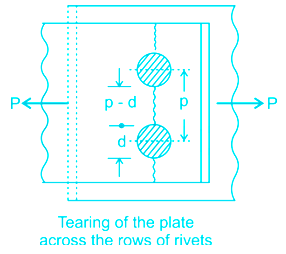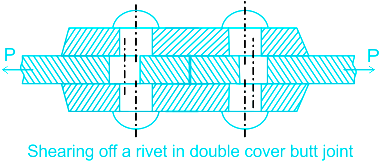Solutions
Concept:
The efficiency of riveted joints id defined as the ratio of strength of riveted joint to the strength of unriveted solid plate. The strength of the rivested joint is the lowest value of Ps, Pt and Pc.
Strength of solid plate is given by
P = ptσt
Therefore the efficiency is given by
η =
(i) Tensile strength of Plate between rivets
Due to the tensile stresses in the main plates, themain plate or cover plates may tear off across a row of rivets as shown in Fig:

Pt is the tensile strength of plate between rivets and is given by
The resistance offered by the plate against tearing is known as tearing resistance
(ii) Shear Strength of Rivet
Shearing of the rivets: The plates which are connected by the rivets exert tensile stress on
the rivets, and if the rivets are unable to resist the stress, they are sheared off.
The resistance offered by a rivet to be sheared off is known as shearing resistance or shearing strength or shearing value of the rivet



d = Diameter of the rivet hole, τ = Safe permissible shear stress for the rivet material, and n = Number of rivets per pitch length
Shearing resistance or pull required to shear off the rivet per pitch length:
So, the strength equation for the rivet in the double-riveted joints is given by:
(iii) Crushing Strength Pc of the plate is given by
Pc = d x t x σc x n
d = Diameter of the rivet, t= thickness of the plate, σc = compressive strength of the plate.



 Get latest Exam Updates
Get latest Exam Updates 





 ×
×






